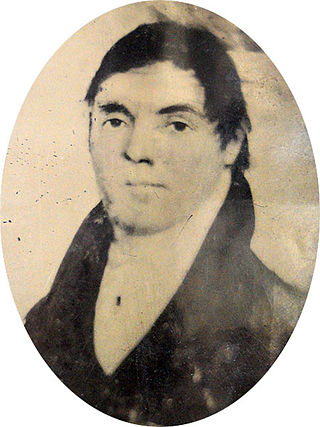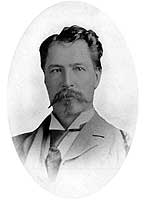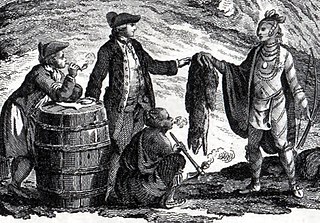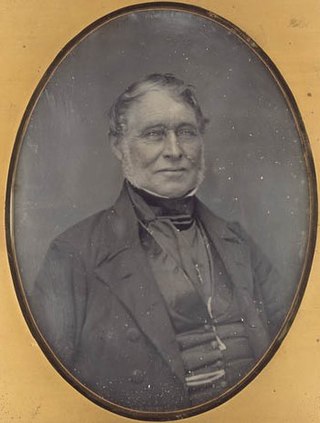Related Research Articles

John McLoughlin, baptized Jean-Baptiste McLoughlin, was a French-Canadian, later American, Chief Factor and Superintendent of the Columbia District of the Hudson's Bay Company at Fort Vancouver from 1824 to 1845. He was later known as the "Father of Oregon" for his role in assisting the American cause in the Oregon Country. In the late 1840s, his general store in Oregon City was famous as the last stop on the Oregon Trail.

Cuthbert "James" Grant was a prominent Métis leader of the early 19th century. His father was also called Cuthbert Grant.

The Battle of Seven Oaks was a violent confrontation in the Pemmican War between the Hudson's Bay Company (HBC) and the North West Company (NWC), rivals in the fur trade, that took place on 19 June 1816, the climax of a long dispute in western Canada. The Métis people fought for the North West Company, and they called it "the Victory of Frog Plain".

Thomas Douglas, 5th Earl of Selkirk FRS FRSE was a Scottish peer. He was noteworthy as a Scottish philanthropist who sponsored immigrant settlements in Canada at the Red River Colony.
Pierre Guillaume Sayer was a Métis fur trader who challenged the monopoly of the Hudson's Bay Company (HBC) of the fur trade in the Red River region. Ultimately this led to its end.
Angus Bethune was the oldest son of the Reverend John Bethune. He had several distinguished brothers: Alexander Neil, who became Anglican bishop of Toronto; John, Anglican clergyman, dean of the diocese of Montreal and principal of McGill University; James Gray prominent Upper Canada businessman; Donald, an important political figure in Upper Canada.

Colin Robertson was an early Canadian fur trader and political figure. Born in Scotland, for much of his adult life he was engaged in the North American fur trade, working at different times for the North West Company and the Hudson's Bay Company. He led the Hudson's Bay Company expedition to Lake Athabasca.
Angus Shaw was a fur trader and political figure in Lower Canada.
Sarah McLeod is notable in the history of Canada for being involved in a defamation case, the Foss-Pelly scandal.

Maxime Goulet was a Canadian politician. He served as a member of the Legislative Assembly of Manitoba from 1878 to 1886 and was the Minister of Agriculture under Conservative Premier John Norquay.

James Sinclair was a trader and explorer with the Hudson's Bay Company (HBC). He twice led large parties of settlers from the Red River Colony to the Columbia River valley. These were both authorized by the HBC as a part of grandiose plans to strengthen British claims in the Oregon boundary dispute.

The North American fur trade is the (typically) historical commercial trade of furs and other goods in North America, predominantly in the eastern provinces of Canada and the northeastern American colonies. The trade was initiated mainly through French, Dutch and English settlers and explorers in collaboration with various First Nations tribes of the region, such as the Wyandot-Huron and the Iroquois; ultimately, the fur trade's financial and cultural benefits would see the operation quickly expanding coast-to-coast and into more of the continental United States and Alaska.
Elzéar Goulet was a Métis leader in the Red River Colony, which later became the province of Manitoba, Canada. He was a supporter of Louis Riel's provisional government and was murdered by Canadian troops under the command of Col. Garnet Wolseley, after the suppression of the Red River Resistance.

Archibald McDonald was chief trader for the Hudson's Bay Company at Fort Langley, Fort Nisqually and Fort Colvile and one-time deputy governor of the Red River Colony.

Major The Hon. Archibald Norman McLeod J.P., was a partner of the North West Company and a political figure in Lower Canada. In 1805, he built Fort Dunvegan. He was a member of the Beaver Club and represented Montreal West in the Legislative Assembly of Lower Canada from 1810 to 1814. He fought in the War of 1812 as a Major with the Corps of Canadian Voyageurs and the Canadian Voltigeurs. McLeod Lake, British Columbia is named for him.
Joseph William McKay (Mackay) (31 January 1829 – 17 December 1900) was a fur trader, businessman, politician and explorer who had a long career in the employ of the Hudson's Bay Company in Canada.

Lac Île-à-la-Crosse is a Y-shaped lake in the north-central region of the Canadian province of Saskatchewan on the Churchill River. At the centre of the Y is the town of Île-à-la-Crosse, the second oldest town in Saskatchewan. The Churchill exits the north-east arm and flows east to Hudson Bay through a series of lakes. The Churchill enters at the north-west arm called Aubichon Arm or Deep River. Upstream it leads north-west to Athabasca Country passing Churchill Lake, Peter Pond Lake, Lac La Loche and on to the Methye Portage leading to Lake Athabasca.
Isabella Mainville Ross was the first female registered landowner in British Columbia. She was a Métis woman, the daughter of Joseph and Josette Mainville.

Matooskie, also known as Anne "Nancy" McKenzie, was a First Nations woman of the Chipewyan nation in Canada. The daughter of Scottish-Canadian fur trader Roderick Mackenzie, Matooskie was abandoned by her father as a young girl, and was left in the care of North West Company trader John Stuart. She was later abandoned by her first husband, John George McTavish. Supported by the Hudson's Bay Company, Matooskie and her family moved to various Hudson's Bay outposts across Western Canada, before settling at Fort Vancouver in the Columbia District following the death of her second husband. In the later years before her death in 1851, she accompanied her daughter and son-in-law.
John George McTavish was a Scottish-born fur trader who played a significant role in the North West Company's activities in North America during the early 19th century. He entered the North American fur trade in 1798 with the North West Company, wherein he challenged the monopoly of the Hudson's Bay Company. Personal controversies arose from his marriages, notably abandoning his common-law wife Matooskie, an Indigenous Canadian woman, for Catherine Aitken Turner, sparking condemnation and rumours.